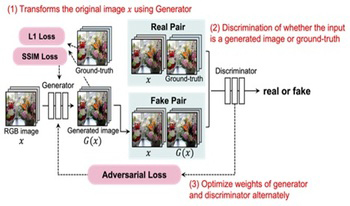
Color-space conversion technology is important to output accurate colors on different devices. In particular, CMYK (Cyan, Magenta, Yellow and Key plate) used by printers has a limited range of representable colors compared with RGB (Red, Green and Blue) used for normal images. This leads to the problem of loss of color information when printing. When an RGB image captured by a camera is printed as is, colors outside the CMYK gamut are degraded, and colors that differ significantly from the actual image may be output. Therefore, printers and other companies manually correct color tones before printing. This process is based on empirical know-how and human sensitivity and has not yet been automated by machines. Therefore, this study aims to automate color correction in color-space conversion from RGB to CMYK. Specifically, we use machine learning, utilising a large color-conversion database owned by printing companies, which has been cultivated through past correction work, to learn the color-correction techniques of skilled workers. This reduces the burden on the part of the work that has been done manually, and leads to increased efficiency. In addition, the machine can compensate for some of the empirical know-how, which is expected to simplify the transfer of skills. Quantitative and qualitative evaluation results show the effectiveness of the proposed method for automatic color correction.
Ikumi Hirose, Ryosuke Yabe, Toshiyuki Inoue, Koushi Hashimoto, Yoshikatsu Arizono, Kazunori Harada, Vinh-Tiep Nguyen, Thanh Duc Ngo, Duy-Dinh Le, Norimichi Tsumura, "Acquisition of Color Reproduction Technique based on Deep Learning Using a Database of Color-converted Images in the Printing Industry" in Journal of Imaging Science and Technology, 2023, pp 1 - 6, https://doi.org/10.2352/J.ImagingSci.Technol.2023.67.5.050402
- received May 2023
- accepted August 2023
- PublishedSeptember 2023
| All | Flower | Scene | Human | Object | |
|---|---|---|---|---|---|
| Train | 6641 | 171 | 1056 | 612 | 544 |
| Validate | 738 | 21 | 119 | 72 | 54 |
| Test | 1000 | 190 | 87 | 71 | 30 |
 Find this author on Google Scholar
Find this author on Google Scholar Find this author on PubMed
Find this author on PubMed
 Open access
Open access